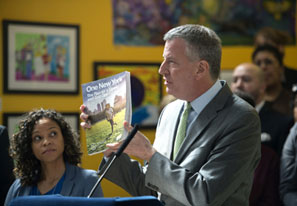
Follow New York politics closely, and you’ll become familiar with the Twitter hashtag #deblasiosnewyork. Political reporters have made a pastime out of slapping the label on all manner of petty, humorous, or weird stories. The initial purpose of this inside joke was to skewer those who think that Mayor Bill de Blasio is taking Gotham back to the “bad old days.” Over the last 14 months, the joke’s boundaries have expanded to suit the absurdist preferences of the city’s press corps. A tweet about coyotes in Riverside Park is as good a candidate for #deblasiosnewyork as is a story about the 16 percent uptick in the city’s murder rate.
The hashtag may be a joke, but OneNYC, a 332-page document released last week to “articulate the goals and long-term agenda of the de Blasio administration,” is not. It’s the real #deblasiosnewyork: a blueprint for the kind of city that the ambitious mayor wants to leave behind when his days in City Hall are over—whenever that might be. OneNYC is a serious and professional document, portraying a city in the hands of efficient and forward-thinking planners. But a closer look reveals an agenda riddled with left-wing pieties and noticeably lacking in humility about the limits of public policy.
Relying heavily on urban buzzwords like “resiliency” and “environmental justice” and drawing fuzzy connections between income inequality and climate change, OneNYC is laundry-list progressivism at its most majestic: “New York City will have an inclusive, equitable economy that offers well-paying jobs and opportunity for all New Yorkers to live with dignity and security.” The goals are pie-in-the-sky: “[If] OneNYC anti-poverty initiatives are implemented, 800,000 New Yorkers would be lifted out of poverty or near poverty by 2025.” The document is larded with language to stir the blood of idealistic graduate students: “Too often, a person’s home address, parents’ income, race, or other demographic traits can weigh on their life outcomes—from educational attainment to future earnings, and even life expectancy. We must change these underlying odds.”
The mechanisms for instituting this progressive utopia are familiar—minimum-wage increases, magically affordable housing, massive infrastructure “investments,” artists-in-residence at public agencies, broadband for all, widespread composting and recycling, and so on. Absent is any explanation of how all of this will be paid for. The mayor promises that those details are forthcoming. “The specific things that cost city money or capital expense money will be accounted for on May 7,” he said at a press conference. Mark your calendar. What are the chances that de Blasio’s funding plan will look a lot like the $3.4 billion in future health-care “savings” that he used to give city teachers retrospective raises last year?
Some elements of the OneNYC program are innocuous—eliminating all landfill waste by 2030, for instance, seems like a noble, if far-fetched, goal. But in the area of “criminal justice reform,” implementing OneNYC could do real harm to the city and reverse the public-safety gains made under Mayors Rudolph Giuliani and Michael Bloomberg.
Throughout his first 16 months in office, de Blasio has consistently voiced support for Broken Windows-style policing. That he has done so in the face of sustained criticism from his left-wing allies is good news, at least to those who understood Broken Windows’ role in reducing New York’s crime rate over the last three decades. This week, after New York police arrested 143 people during a protest related to the Freddie Gray case in Baltimore, the mayor issued a passionate defense of quality-of-life policing, saying that his administration “won’t move away from the strategy because it works.”
By contrast, however, the OneNYC document envisions a city in which “fairness” can be employed as a “crime reduction tool” and in which “cohesive, engaged neighborhoods”—not order maintenance—somehow become the principal agent in crime prevention. OneNYC proposes a rebalancing of the relationship between cop and criminal: “People are more likely to obey the law when they believe those who are enforcing it have the legitimate authority to do so.” The document makes repeated reference to “unnecessary incarceration,” a coinage that necessarily implies frequent wrongdoing on the part of the NYPD. This vision of a chastened and restrained NYPD is more in line with the old de Blasio, who campaigned on reforming the relationship between police and communities.
How are we to interpret, then, the mayor’s increasingly adamant stance that New York needs Broken Windows policing more than ever? Perhaps, after nearly a year and a half as mayor, de Blasio has developed respect for the difficult and often thankless job of policing a city like New York. Or, having been stung by the backlash among the NYPD’s rank-and-file last December, he may have opted for a new strategy of public support and private reform. If so, he’s playing the complicated game of serving two masters. His allies on the anti-cop Left are surely preparing to test de Blasio’s commitment to Broken Windows by escalating their Black Lives Matter street protests.
OneNYC’s hedging on Broken Windows is especially alarming given the city council’s recent moves toward decriminalizing certain “low-level,” quality-of-life offenses such as turnstile jumping and drinking alcohol on the street. De Blasio has thus far said that he opposes these decriminalization efforts. If the council gets its wish, though, and if OneNYC’s criminal-justice reforms come to fruition, New York could become a place where failure to compost is frowned upon but urinating in public is not. Devotees of the #deblasiosnewyork hashtag may call such fears overblown, or they may actually think that living and working in such a city would be an improvement. But for almost everyone else, this is a joke we’ve heard before, and it wasn’t funny the first time.